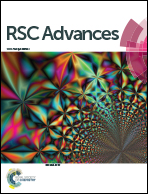Structure and growth mechanism of self-assembled monolayers of metal protoporphyrins and octacarboxylphthalocyanine on silicon dioxide†
Abstract
In this work, we studied the structure and the growth of various conjugated macrocyclic SAMs (two protoporphyrins ZnPP and FePP, and one phthalocyanine ZnPc(COOH)8) on silicon dioxide previously functionalized by aminopropyltrimethoxysilane (APTMS) for covalent grafting of macrocycles on the surface. The samples were characterized by atomic force microscopy (AFM), ellipsometry, contact angle measurements, Fourier transform infrared (FTIR) and UV-visible spectroscopy. A growth model of macrocycle layers in three steps was established from ellipsometry and UV-visible results at various deposition times. Firstly, a fast adsorption of macrocycles occurs on the surface in a disordered way followed by a rearrangement phase. Then, the layers get denser by adsorption of supplementary macrocycles on the surface. Spectroscopic and morphological analyses reveal a specific structure for each deposited macrocycle. The size of the macrocycle core and nature of the metallic atom are shown to be key factors which govern orientation and assembly of macromolecules on the surface. Finally, the essential issue of film stability in an ambient atmosphere has been addressed.


 Please wait while we load your content...
Please wait while we load your content...